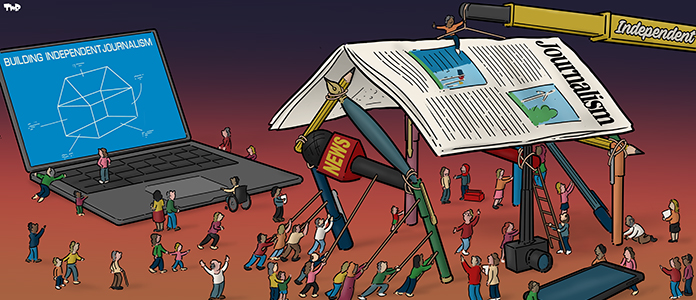A glance at the electoral map from Germany's February 23rd federal election reveals a stark reality: the voting patterns closely mirror the Cold War division that preceded the country’s reunification in 1990. While former West Germany is painted in the traditional black and dark blue of Friedrich Merz's conservative CDU/CSU, the federal states that were once part of the German Democratic Republic are awash in the light blue of the far-right Alternative for Germany (AfD), led by Alice Weidel.
“Why do East and West vote differently?” ponders Mona Trebing on ZDF's news portal. Drawing on insights from Oliver Lembcke, a political scientist at Ruhr University Bochum, she points to the East's weaker party loyalty and less robust civil society as key factors that enhance its susceptibility to populist movements. Trebing also underscores the significance of the impressive voter turnout in eastern states – 77.7% in Saxony-Anhalt and 81.5% in Brandenburg – proved instrumental in AfD's triumph, with the party successfully capturing first-time voters.
Where immigration is most needed, it’s most rejected
Writing for the Frankfurter Allgemeine Zeitung, Markus Wehner observes that AfD's success stems from multiple sources: its ability to mobilise previous non-voters, a consolidated core electorate, and its increasing normalisation in media discourse – which has made voters less hesitant to publicly acknowledge their support. Wehner emphasises that immigration policy emerged as a pivotal factor, particularly as an issue that undermined traditional parties. For voters discontented with the government's current migration stance, AfD presented itself as an unambiguous protest vote.
In The New York Times, Amanda Taub identifies a pattern in Germany's experience that resonates across developed nations grappling with migration challenges. Following reunification in 1990, East Germany witnessed a substantial exodus of its young and educated population – particularly women – westward in pursuit of better prospects.
This emigration, Taub argues, engineered a vicious circle: the affected regions were left with a predominantly elderly population and demographics more susceptible to far-right ideology, leading to deteriorating public services and economic stagnation. Local discontent, frequently directed at the establishment and mainstream parties blamed for regional decline, has bolstered support for AfD's anti-immigration stance.
Taub points to a striking paradox: these very regions most desperately require immigration to maintain services and care for their ageing population. The withdrawal of traditional parties from campaign efforts in these areas has only reinforced the narrative of “abandoned regions”. This pattern, the author argues, illustrates the universal threat faced by developed countries characterised by significant regional economic disparities.
The numbers tell the story
With its fertility rate plummeting to 1.35 children per woman in 2023, pushing it into what the Financial Times calls “ultra-low” fertility territory, Germany faces an uncomfortable truth: it desperately needs immigrants. Yet, as economists Marcel Fratzscher and Sabine Zinn argue in Die Zeit, the country's leading politicians are moving in the opposite direction, with Christian Democrat leader Friedrich Merz promising to tighten naturalisation requirements and AfD's Alice Weidel calling for “remigration” – the return of people with immigrant backgrounds to their countries of origin.
Economists point out that Europe's economic powerhouse requires an annual influx of 400,000 migrants to maintain stability, with 1.7m current job vacancies and 5m workers set to retire in the next decade. Foreign workers, the researchers note, have already accounted for 80% of employment growth over the past five years, but bureaucratic barriers are hampering further immigration. In their column, Fratzscher and Zinn propose integrating 1.6m foreign workers by 2029, streamlining qualification recognition and strengthening integration programmes, warning that without such reforms, Germany risks losing both its competitiveness and economic prosperity.
Spain's economic renaissance, reported in these pages in January, has been largely driven by mass immigration, write Antonio Maqueda and Yolanda Clemente in El País. According to their analysis, nearly a million working-age Spaniards vanished from the labour force over the past six years, while more than two million foreigners stepped in to fill the void. The impact has been significant, they write: immigrants took 88% of new jobs created in 2024, contributing an estimated €60bn to the economy.
The share of foreign-born residents has surged from 14.6% to 20.9% in eight years, they point out, with these newcomers – predominantly Spanish-speaking Latin Americans – becoming the backbone of key sectors. Maqueda and Clemente argue that this demographic shift serves a dual purpose: powering economic growth while propping up the pension system as the native population greys.
Not everyone is cheering Spain's immigrant-powered boom. Young Spaniards, particularly those flocking to the far-right Vox party, see this influx differently, writes Estefanía Molina in the same newspaper. Their opposition is not merely xenophobic, they argue. They worry that migrants' willingness to accept lower wages will further erode their already precarious job prospects. Many see immigration as merely a convenient fix for the pension system, benefiting their parents' generation at their expense.
When birth-death gap mirrors Great War statistics
Low birth rates and reliance on immigration are no longer phenomena confined to Western Europe, as countries in the centre and east of the continent – once primarily sources of emigration – find themselves becoming destinations. The Czech Republic has seen births plunge to levels not seen since record-keeping began in the mid-18th century, with around 85,000 babies born in 2024 – a quarter fewer than in 2021– reports Jan Beránek in Hospodářské noviny.
Yet the country of ten million is rapidly becoming a magnet for immigrants, with more than one million foreigners now calling it home, writes Přemysl Spěvák in Deník. Ukrainians form the largest group at nearly 580,000, followed by Slovaks and Vietnamese. The country hosts the EU's highest proportion of Ukrainian refugees relative to population – some 35 per 1,000 inhabitants – with immigration adding 15,000 to the population in the first nine months of 2024 alone, mirroring a broader European trend where the EU is now home to 27m foreigners, or 6% of its population.
Fico survives government crisis in Slovakia
Hospodárske noviny | 19 February | SK
Despite mass protests sweeping across Slovakia and a crumbling parliamentary majority, Robert Fico, the wily leader of the Smer party, has managed to cling to power. "Fico has resolved the crisis through sheer power politics”, observes political scientist Darina Malová in Hospodárske noviny. The increasingly pro-Russian prime minister's cabinet reshuffle saw Smer secure control of two additional ministries, expanding its portfolio from seven to nine at the expense of its coalition partners – the more moderate Hlas (itself a Smer offshoot) and Andrej Danko's far-right party SNS. The manoeuvre appears designed to rein in rebellious MPs from both junior parties who had threatened the coalition's stability.
In partnership with Display Europe, cofunded by the European Union. Views and opinions expressed are however those of the author(s) only and do not necessarily reflect those of the European Union or the Directorate‑General for Communications Networks, Content and Technology. Neither the European Union nor the granting authority can be held responsible for them.

Do you like our work?
Help multilingual European journalism to thrive, without ads or paywalls. Your one-off or regular support will keep our newsroom independent. Thank you!













Join the discussion
Become a member to translate comments and participate